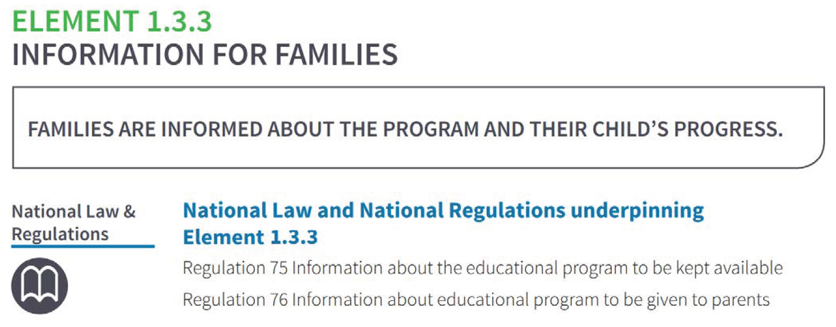Facilitating and maintaining ongoing partnerships with families and the community is an important part of an educator's role in education and care settings. Supporting children to learn about the community and become active citizens in the world around them is something both educators and families can do together. In this topic, we will explore how educators can foster positive, professional and ongoing relationships with families to enhance the child's learning journey.
By the end of this topic, you will understand:
- Ensuring families are informed about the service
- Strategies for involving families in the service and decision-making
- What effective reciprocal relationships look like
- How to engage in positive communication with families and share their child's learning journey
- The importance of communicating with families about their child, including when incidents occur.
Within the role of educator, you will share information with families about the service policies or procedures and other operational requirements, including aspects that support the care of their child. Having a process for regular exchange of information with families under pins informing families.
Sharing information with caregivers about the care and education of their children is important. It commences when the family and child begin with the service. It is vital to building trust by explaining how your service works and what the children will experience.
Services might provide a brochure or a simple factsheet that outlines the service induction and enrolment process for families. It would be a reference and will provide information including:
- The service's induction and enrolment process for families.
- Information about the educational program and practice, such as how the service develops programs, what the children will be offered, how this links to child development and the Approved Learning Framework.
- Information about access to Government funding/rebates for families using education and care and how to apply for Government funding.
- Policies and processes relevant to families including:
- Enrolment Policy and Procedure
- Orientation for Families Policy and Procedure
- Fees and Charges Policy and Procedure
- Grievances and Complaints Policy and Procedure
- Safe Sleep and Rest Policy and Procedure
- Immunisation Policy and Procedure
- Exclusion Policy and Procedure.
- National Quality Standards or Regulations relevant to the information provided to families.
- Links, references and/or documents that families may use to gain further information such as services and resources for family and information about bodies such as ACECQA.
The information provided to families would include practical information to assist families in navigating the orientation and enrolment process, including:
- options for organising your service tour
- information on what to bring with you on your service tour
- details of what information you will be required to provide
- information and documents the service will provide
- details of how inductions work and what is the process
- information on timeframes, e.g., When can we start?
- other information families need to know before their child starts at the service
- details of who will be the contact person for the family.
Activity 2A
Communicating Information with Families
List at least seven topics you could talk to families about during the initial enrolment phase to ensure they know what to expect from education and care services.
Ensure that you keep notes for future reference, as this information will support your assessment and professional practice.
When early childhood services work in partnership with families, the children develop a sense of community, and all parties work together to enhance children's learning and opportunities.
There are many ways families can be involved in the service, including contributing to the service within an advisory, consultative, or decision-making role. For example, families could:
- Provide feedback on service policies and practices
- Add to the service menu through consultation and relevant recipes
- Join parent advisory committees or become a board member or join the committee of management
- Be consulted for feedback and ideas around the Quality Improvement Plan (QIP) and NQS areas delivered
- Assist with specific skills the service needs, such as accounting, recruitment, editing or other tasks like handy-person or cook.
- Contribute to the educational program where the family member has knowledge or expertise
- Be involved in special events such as fund raising, cultural festivals and social activities.
Involving the families in broader aspects benefits the parents and the service. It provides an opportunity for families to be involved and meet other families. It also allows them to build an understanding of how the service operates and provide feedback about possible improvements.
Example

Anne is a human resources professional who volunteered to assist the service when they had a recent round of recruitment. She helped to cull the applications and sat on the interview with the director. She also gave advice after the reference checks were completed.
Jeanine is a police officer in her work life and is also a parent at the service. Her son Lucas attends the Kindy Room. When she enrolled Lucas, the educators and director asked if there were any skills or talents she could share. She decided that she could arrange to bring the police car to the service on a quiet day and conduct a talk with the children about seeking help from police officers.
Gathering and Sharing of Information
Gathering
When families first enrol their child(ren), several forms of information are required to provide the best care and education.
These can include information about:
- The child's routine
- Care needs
- Likes and interests
- Culture
- Languages
- Foods they have eaten and enjoy
- Contact details of family members
- Parent consents to a range of care provisions in the service
- Health records.
Educators must, at a minimum, gather the required documents under the Regulations and then seek to enhance their knowledge of the child(ren) to support their transition into care and education. For example, educators might ask new families to complete a "What should you know about me" document for each child joining the service. The document would invite the families to provide information on key areas:
What You Should Know About Me
- My Name
- My Birthday
- My sleep routine and comforters
- My mealtime routine/What I do and do not like to eat
- My toilet/nappies routine
- What I am learning currently
- How I communicate with you
- My favourite things to play with
- My temperament
- Who I live with
- Traditions or events that are important to my family and me
- My self-help skills—can I dress myself / wash and dry my hands?
There are several ways to gather information from the children's primary caregivers/families, including:
- Surveys and questionnaires
- Interviews
- Parent/educator meetings
- Incidental conversations such as during drop-off and pick-up
- Emails.
When gathering information from families, educators can choose to record the information themselves or ask the family to record the information. Once the educator begins documenting information about the child—such as their learning documentation, curriculum, incident or accident records, medication records, attendance records and more—they are required to make that information available to families at any time.
Activity 2B
Family Questionnaire or Survey
Consider what you need to know as an educator caring for and educating a child. Create a questionnaire or survey you would send to families of the children in your room to ensure you can care for an educate them effectively. Your survey or questionnaire must include at least ten questions.
Ensure that you have a record of the survey for future reference, as this information will support your assessment and professional practice.
Sharing
Service policies based on the National Quality Standards of Educational Programs and Practices and Collaborative Partnerships with Families require educators to share information with families about children's learning and development. Services will ensure they build relationships with the parent to achieve quality outcomes for children by using active communication, opportunities for consultation, and collaboration.
Information will be shared with families about the service induction and enrolment process, including a summary of the enrolment process and induction to provide families with guidance on 'what to expect'. Practical details about induction and enrolment as they arise, such as:
- service tour
- what to bring on your service tour
- what information will be required
- information and documents the service will provide
- how inductions work and what the process is
- when the child can start
- what else the family may need to know before their child starts.
Services will share information on available financial and government support and how to apply for government funding. Information on the National Quality Standards or Regulations relevant to the information provided to families, such as Quality Area 1, The Educational Program and Practice, including how the service develops programs, what the children will be offered and how this links to child development and the Approved Learning Framework.
Educators will ensure that the information they share is child-focused and that families are informed about the program and their child's progress. Parents will share information about the child's relationships, interests and experiences. Educators share positive feedback about the child's progress rather than only telling families about difficulties and behaviour issues that may have occurred. Families can also access their children's learning records to see their progress.
Services will also share information with families about incidents that have occurred to the child at the service. The regulations require parents to be informed as soon as possible (and no later than 24 hours after the incident occurred). The service will demonstrate sensitivity during the conversation to inform the parent about the incident. They will provide clear and concise information that does not cause undue alarm but ensures the parent understands what has happened. Parents will be supported during the process, and educators will respond professionally to their questions and their responses.
Quote
Share information with families and have it available! Set the stage for the habit of communicating and building a relationship from the first encounter4.
Shared Decision-Making
Engaging in shared decision-making requires a consultation process where families and educators work together to determine the best approach for the child. Educators should sit with families and discuss options and then create a plan. Once the plan is implemented, educators and families should engage with each other on an ongoing basis.
Example
A new child starts, and the educators and parents work together to set up a routine around eating and sleeping as close to the child's home routine.
The child begins, and the parents share with the educator that the child has been so tired at the end of the day that they are falling asleep on the way home. They decide together to move the child's sleep back an hour to try to avoid this happening.
Families and the Learning Journey
Parents can contribute ideas and suggestions to support their child's learning journey. Educators can support children's learning by asking families questions and learning more about their home life.
Case Study

Ana has been observed in the home corner playing Mum and has been cooking dinner for the big party. Ana is Brazilian. She has been talking about black beans and saying words that are not familiar to the educators. When the educator (Tara) recorded the observation, she sent it via the online platform to Ana's mother and asked a question. 'Ana was cooking Brazilian dishes. Can you share some of her words and what they mean? Does she help you cook at home?'
Ana's Mum Juliana wrote back and shared the words and recipes for the dishes Ana was cooking.
Tara decided to offer further opportunities for Ana to learn and play. She offered the following extensions:
Printed photos of the dishes, Brazilian words, cooking experience with Brazilian dishes and an invitation to Juliana to come and do some cooking at the service.
What else might you follow up on to enhance Ana's learning?
What resources could you access to support your planning and learning about Ana?
Activity 2C
Family Participation
Read this information sheet from ACECQA about building partnerships to learn more about the requirements to build relationships with families: Quality Area 6, Building Partnerships With Families.
List the characteristics of a genuine partnership between educators and families.
Ensure that you keep notes for future reference, as this information will support your assessment and professional practice.
When caring for young children, we are responsible for keeping parents advised about what happened when their child was in our care.
Example
Imagine a parent bathing their child at the end of the day, and they find a bruise they have not been told about. What might they think?
As educators, we must consider all the care needs and daily functions of caring for children and ensure that we document records and communicate these to families.
Educators should follow the below approach and stick to the golden rule of overcommunicating—it is better safe than sorry.
Quote
Sometimes changes to care routines happen. Communicating changes is the key! Communicating this each day is essential.
There are many ways we can communicate to families concerning changes to the child's care needs and educational programs.
Example
When a care routine is missed—for example, a child misses their bottle because they slept longer than planned and then wanted lunch straightaway—it is best to let the parent know what happened. You might call them or send a message to share in the decision-making around what to do next.
Our interactions with families are important and require a focused effort to ensure the family and child(ren) are supported in their time in our care. Children respond to the interactions they have with educators and the interactions between their families and educators. When building trust with children, we should ensure our interactions are positive, welcoming, and engaging.
Example
'At Little.ly Early Learning Centre, we see families and children as an extension of our family, and we take our responsibility to deliver high-quality care and education to heart. We believe that, more than anything, the relationships we build and maintain with families and children are vital to achieving this. These relationships directly affect how children form their own identity, whether or not they and their families feel safe and supported, and ultimately, their sense of belonging'. (From Little.ly CR1 Enrolment Policy)
Activity 2D
Communicate with Families Policies
Read the Little.ly CR1 - Interactions with Children and Families Policy and identify and list at least five expectations of staff concerning:
- Interactions with children at Little.ly
- Interactions with families at Little.ly.
Ensure that you keep notes for future reference, as this information will support your assessment and professional practice.
Providing care functions to children in an education and care setting is central to the educator's role. Educators work with families and primary carer(s) to determine the care needs, seek information about the child, and plan care arrangements. Educators then communicate on an ongoing basis about the care that is provided.
Enrolment
The first interactions with the family occur during enrolment. To ensure that positive relationships are established, there should be a clear process to ensure information is gathered, rapport is built, and plans are put in place to provide the best possible care to the child(ren). Ensuring a range of strategies to facilitate ongoing shared decision-making is also important.
Example
Little.ly Enrolment process
- A family will indicate an interest in enrolling either by phone, email or attending the service
- Management will then arrange a time for the family to come and tour the service
- During the tour of the service, the centre direct, second in charge or delegated educator will discuss relevant information about the service with the families and allow for collaboration about questions and concerns
- Families will be unhurried and encouraged to take their time
- On completion of the tour, the families will be given a Families Policy Handbook and will be provided with current vacancies
- Families will be informed of the priority access service.
(From Little.ly ML1 Enrolment Policy)
Activity 2E
Enrolment Policies
Read the Little.ly Enrolment Policy and summarise the responsibilities of educators during enrolment at Little.ly.
Ensure that you keep notes for future reference, as this information will support your assessment and professional practice.
A Welcoming Environment
The process for developing rapport and supporting a family through enrolment includes creating a welcoming environment. A welcoming environment for all families can be established using communication techniques that build rapport and respect. Educators can be welcoming toward the parent by using a positive tone to greet and communicate with them.
Educators will present positively towards families by smiling, using open body language, and always being respectful, professional, and courteous. In a welcoming environment, parents and families are afforded the space to talk, ask questions and become relaxed in the environment.

Educators will use rapport-building strategies, including:
- Being personable and positive
- Being confident in answering questions, so the family felt confident in the service
- Welcoming families to sit and showing them information
- Not rushing families
- Acknowledging the child and remembering names
- Acknowledging any concerns of the family.
Visits to the service are typically called transition visits or orientation visits. They can vary depending on the child and family and the service. Some services have guidelines around the orientation or transition visits to ensure the child settles well and enough communication is shared between families and educators.
Supporting a family through enrolment is important for ensuring the future relationship is successful. Much of the enrolment and orientation process is about building trust with the families. They need to trust that you can support their child in line with their expectations.
Sharing information with a family about the service can let them know what to expect and allow them to ask any questions they have. This information can be publicly available on a services website or parent information handbook. This allows the information to be accessible to families to be informed.
Families will have different needs and expectations of the education and care team taking care of their children. One family will be happy to follow what the centre thinks is best and adjust to the centre routine; another family will ask lots of questions and have specific care needs they want to be met. As educators, we can adjust our approach to support each family's journey.
Note
The purpose of the Little.ly Families Orientation Policy is:
To ensure families and children feel safe, secure and comfortable before commencing within the service and providing staff with an opportunity to learn about the child and build relationships with the families.
Quote
Trust is a must!
Activity 2F
Orientation Policies
Read the Little.ly ML8 – Families Orientation Policy and identify and list at least five responsibilities of educators during the orientation of a family at Little.ly.
Ensure that you keep notes for future reference, as this information will support your assessment and professional practice.
Following on from the initial enrolment and orientation process, you will then engage with families on an ongoing basis to update and modify care plans for children based on a range of factors, including:
- development
- changes to routine
- excursions
- health changes
- medical conditions.
Creating regular opportunities for consultation with families is important. Arranging meetings and ways of communication to consult with and build a partnership with families is important. Communication should occur daily with families, and educators should consider different means of communication such as email, phone and formal or informal parent meetings. During these meetings or communications, educators must communicate to show understanding for each child and their family.
Watch
Watch the following YouTube video to explore more about creating partnerships with families: TAPS Partnerships with Families Part 1 of 5
Activity 2G
Shared Decision-Making
Define shared decision-making and list three ways an educator can ensure they have ongoing opportunities for families to engage in shared decision-making.
Ensure that you keep notes for future reference, as this information will support your assessment and professional practice.
The National Law and Regulations set out the requirements that services must meet. Education and Care services are required to share information about the child's education and the service program. The program and practices link to the Approved Learning Framework. In early childhood, this is Belonging, Being and Becoming: The Early Years Learning Framework (EYLF).
The National Quality Framework outlines the requirements and the related Regulations related to families and the educational program. Quality Area 1: Educational Programs and Practices are in place to ensure that the program and service practices enhance children's learning and development. It also required services to engage with families and share information about children's learning and development.

Building effective reciprocal relationships with families are based on open communication and mutually respectful relationships that value the contributions made by each other.
Communicating information with families is a platform for building reciprocal relationships. The service can share information about the program and the child's progress with families via email, phone, online and in person. Educators can also share the children's records of progress and examples of their work.
There are many types of documentation that educators share with families to communicate with families about the program and the child's progress, including:
| Individual Children's Progress |
|
| Group Program Information |
|
Understanding Family and Community Context
Services will communicate in ways that show understanding of each child and their family and community context. When working with families and children, educators identify that each one comes from a unique culture and family situation. It is important to respect the diversity of each family and be sensitive to their traditions and needs.
You will gain their trust to build relationships by understanding the family and community context. You can communicate more effectively by respecting their culture and background.

Communicating with families from diverse backgrounds and situations in a culturally appropriate manner requires respect for their different cultural backgrounds and beliefs. It is essential to be aware of the different needs of families from diverse backgrounds and to be able to communicate with them effectively.
Educators will display empathy and understanding when communicating with people from diverse backgrounds and situations. They will avoid jargon and use words that are easily understood. They will observe cultural practices such as gender roles of who to communicate with, level and types of eye contact, and level of formality, such as using Mr or Mrs rather than first names for people older than the educator or older family members. If needed, they will use the services of an interpreter.
Educators would ensure that they are aware of the child's family make-up, whether they have siblings, where the child is in the family, e.g., youngest. They would consider the parents and their working situation, where they work and how long the commute is to the service. They would also have knowledge of the family's cultural background and their links to their community, e.g., attending a local church or being active in a community sustainability program.
Children's services need to be inclusive and cater to the needs of all families. Service information needs to be available in various languages for families who speak languages other than English. This supports children's care services to be culturally appropriate and responsive to the needs of all families. Information can be accessible to all families when it is provided in various formats. This includes translated materials, interpreters, and culturally appropriate formats. It ensures that everyone can access the information they need, regardless of their background, first language, or accessibility needs.
Tip
Educators can refer to the child's profile to understand the child's family and community context.
Educators use this understanding to employ communication strategies tailored to the child and family context. For example, a family where both parents are professionals may appreciate communication that includes information about the policies and service philosophies.
Example
Suppose a child is the eldest sibling and the first in the family to attend education and care services. In that case, the educator can adjust communication to be sensitive to the family and child in an unfamiliar situation. If the child is the 4th sibling and the previous three children have attended the service, the family may be relaxed and familiar with the environment. Similarly, with knowledge of the family's community context, for example, their cultural or religious background, the educator can be sensitive to how they present information and communicate with the family.

